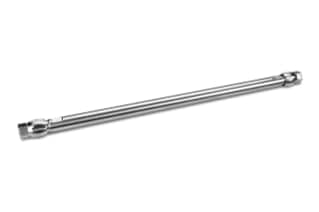
XBridge Protein BEH SEC, 125 Å Columns, containing 3.5um particles are based on the same Waters Ethylene Bridged Hybrid (BEH)-based particle technology and diol-bonded surface coating as used in our successful line of HPLC-based SEC columns. They are best suited to separate proteins ranging from 1,000 – 80,000 Daltons. Note: P/N 176003593 contains an XBridge Protein BEH SEC, 125 Å, 3.5um 7.8 x 300 Column with one vial the BEH125 SEC Protein Std (P/N 186006519)
|
Chemistry |
SEC |
|
Separation Mode |
SEC |
|
Particle Substrate |
Hybrid |
|
pH Range Min |
2 pH |
|
pH Range Max |
8 pH |
|
Endcapped |
No |
|
Bonding Technology |
SEC |
|
Silanol Activity |
Low |
|
Particle Shape |
Spherical |
|
Particle Size |
3.5 µm |
|
Endfitting Type |
Waters |
|
Pore Size |
125 Å |
|
QC Tested |
Protein |
|
Format |
Column |
|
Surface Area |
395 |
|
System |
HPLC |
|
Particle Technology |
BEH |
|
USP Classification |
L33 |
|
Inner Diameter |
7.8 mm |
|
Length |
300 mm |
|
Carbon Load |
12 % |
|
UNSPSC |
41115709 |
|
Application |
Protein |
|
Brand |
XBridge |
|
Product Type |
Columns |
|
Units per Package |
1 pk |
XBridge Protein BEH SEC Column, 125Å, 3.5 µm, 7.8 mm X 300 mm
Easily develop and transfer SEC methods based on laboratory instrumentation with the XBridge Protein BEH SEC Column. The column enables you to also develop methods based on required protein component resolution, and sample throughput requirements.
Developed especially for the chromatography of size-exclusion chromatography of proteins, the XBridge Protein BEH SEC Columns complement Waters existing line of smaller particle size, UPLC-based SEC columns.
Get exceptional column life with the XBridge Protein BEH SEC Column that offers less non-desired, protein and column interactions compared to silica-based SEC columns. It offers HPLC-based SEC resolution of proteins from 10-1,500K Daltons with higher throughput capability. These diol-bonded XBridge Protein BEH SEC Columns offer flow and pressure tolerance for increased sample throughput on HPLC systems. They combine BEH base particle technology with innovative diol bonding processes to deliver column stability, performance, and lifetime.
You may also be interested in the XBridge Protein BEH SEC Guard Column, 125Å, 3.5 µm, 7.8 mm X 30 mm. The column guard is designed to extend the lifespan of your analytical column by eliminating any chemical or particulate contaminants from the mobile phase, and thus, preserving the column and ensuring you get the most accurate and precise results.
Check our complete range of available products, browse through our online inventory, and shop for lab equipment.
How Does SEC Work?
Size exclusion chromatography (SEC) is a Liquid Chromatography technique that is commonly used to monitor protein aggregates throughout the commercialization process of a biotherapeutic protein. This includes monoclonal antibodies. The technique, also known as molecular sieve chromatography, separates molecules based on their size, and in some cases molecular weight. It is usually applied to large molecules or macromolecular complexes such as proteins and industrial polymers. Usually, HPLC-based SEC methods use columns packed with >3 µm particles of an appropriate pore size for the separation of proteins of different hydrodynamic radii. The proteins are ideally separated solely on their relative size in solution, with larger aggregate species eluting prior to the desired monomer drug.